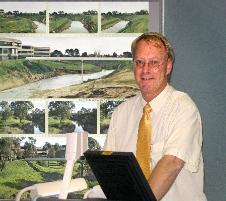20-year documentary a good-news story for Adelaide's Torrens River
Published on 05 May, 2005
A recent PhD graduate is optimistic that his 20-year documentary study shows that concerted affirmative environmental action can make a visible difference to an ailing natural entity over time.
Dr Ashley Holmes was awarded a PhD Visual Arts (Major Studio Project) from the University of South Australia for a thesis entitled, “Bridging Adelaide 2001: photography and hyperimage; hyperreality and the documentary” on April 15, 2004.
 The study first originated when Dr Holmes and an associate, Gavin Blake, documented the Torrens River during 1980 and 1981. Using the bridges that span the river as vantage points, they produced a series of colour photographic prints for an exhibition at the 1982 Adelaide Festival of Arts.
The study first originated when Dr Holmes and an associate, Gavin Blake, documented the Torrens River during 1980 and 1981. Using the bridges that span the river as vantage points, they produced a series of colour photographic prints for an exhibition at the 1982 Adelaide Festival of Arts.
Then in 2001, as part of a Masters award project, Dr Holmes revisited the sites and captured corresponding views in digital format. He then compiled a documentary in hyper-media format that enabled viewers to compare the 20-year old and the contemporary views.
“The visual comparison tells a good-news story,” Dr Holmes says. “One can see the results of research which informed public policies that were defined in the 1970s and implemented during the 1980s and 1990s. The Torrens Valley and the urban catchment has evidently been re-invigorated.”.
“In the earlier views one can see the seriousness of the erosion of sections of the embankments, the choking from exotic flora such as willows, and the impact of the development of new suburbs close to the river. In the later views, the embankments have been stabilised, exotic trees replaced with natives and, in the new suburban areas, systems of ponds established to filter and clean stormwater runoff before it reaches the river.”.
Dr Holmes, who is a multimedia lecturer and Sub Dean of the Faculty of Informatics and Communication at Central Queensland University’s Mackay campus, took a further three years to write up a doctoral thesis about his documentary study.
“Like all natural entities, the Torrens River is actually several rivers,” he says. “Firstly there is the waterway that has worn its course over geological time. Then there are competing culturally constructed versions of the river. These change over time along with social and political concerns and objectives. When the natural, the technological and various other social needs can be reconciled, sustainable development may be achieved.”.
Dr Holmes believes that his documentary shows this to be the case with Adelaide’s Torrens River. “The 20-year temporal comparison of images indicates the river has passed a turning point for the better in terms of its apparent wellbeing,” he says.
Dr Holmes’ thesis also examines the change in photography and visual culture during the transition from traditional photography to digital photomedia practice. He contests the commonly held idea that the digital image is less reliable than the photograph.
“Because the picture is a cultural construct both when it is made and when it is viewed, it matters not whether the image is formed of pixels or of silver grains,” he says. “Contrary to popular belief, the documentary authority of the photo has not been undermined in the transition to digital media.”.
For further information, please contact Ashley Holmes on 4940 7592.

